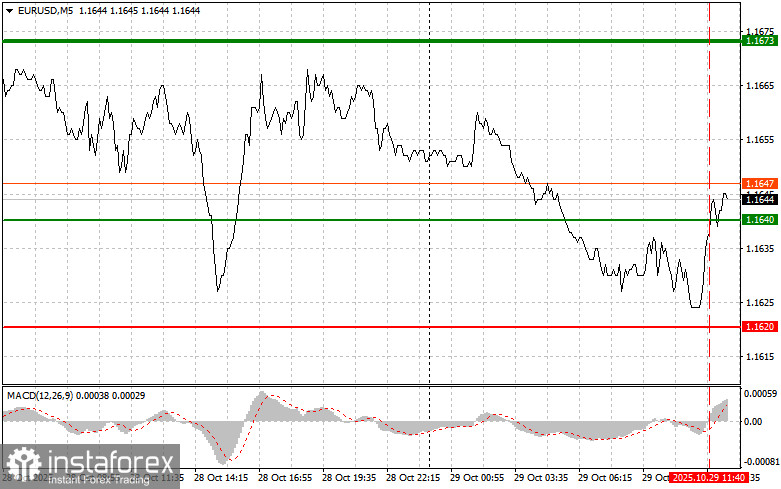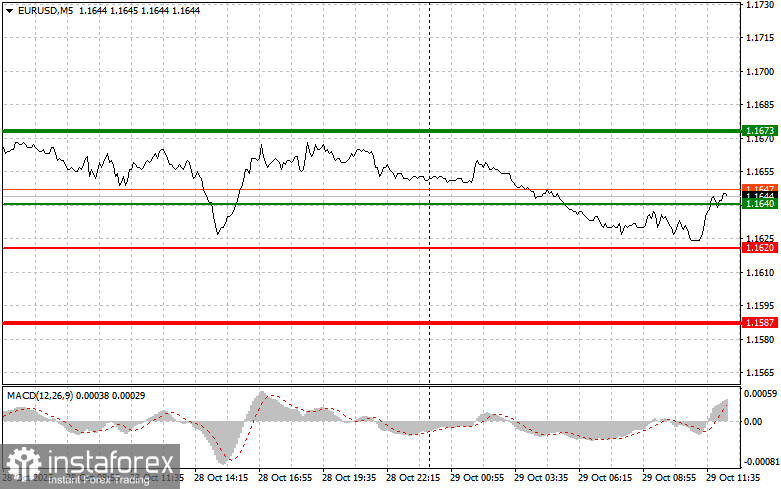Trade Analysis and Recommendations for the European Currency
The price test of 1.1640 occurred when the MACD indicator had just begun moving upward from the zero line — confirming a correct entry point for buying the euro. Since this setup has only recently formed, we'll observe how it develops further.
In the second half of the day, we await an important decision from the U.S. Federal Reserve (Fed). The prevailing market forecasts lean toward a likely interest rate cut. It's important to understand that the impact on the currency market will depend not only on the rate cut itself but also on the tone of the accompanying statement. Market participants will closely analyze every remark from Jerome Powell, searching for clues about the potential acceleration of rate cuts in the near future — something that could significantly weaken the dollar.
If Powell expresses concern about the slowdown in job growth and confirms the Fed's readiness to take further measures to stimulate the economy, the dollar could come under considerable pressure. Conversely, if the Fed Chair remains cautious and emphasizes the importance of fighting inflation, the situation could shift in favor of the U.S. dollar and against the euro.
As for intraday strategy, I'll be focusing mainly on implementing Scenarios #1 and #2.

Buy Signal
Scenario #1: Today, you can buy the euro around 1.1640 (green line on the chart) with a target of 1.1673. At 1.1673, I plan to exit the market and also sell the euro in the opposite direction, expecting a 30–35-point move from the entry point. Euro growth today may depend on a dovish Fed stance.
Important! Before buying, make sure the MACD indicator is above the zero line and just starting to rise from it.
Scenario #2: I also plan to buy the euro if there are two consecutive tests of the 1.1620 level while the MACD is in the oversold zone. This would limit the pair's downward potential and trigger a market reversal upward. Growth toward the 1.1640 and 1.1673 levels can then be expected.
Sell Signal
Scenario #1: I plan to sell the euro after it reaches 1.1620 (red line on the chart). The target is 1.1587, where I intend to exit and buy in the opposite direction, expecting a 20–25-point rebound. Selling pressure on the pair could return at any moment.
Important! Before selling, make sure the MACD indicator is below the zero line and just beginning to fall from it.
Scenario #2: I also plan to sell the euro if there are two consecutive tests of the 1.1640 level while the MACD is in the overbought zone. This would limit the pair's upward potential and lead to a downward market reversal. A decline toward 1.1620 and 1.1587 can then be expected.

Chart Explanation
- Thin green line – Entry price where buying the instrument is possible
- Thick green line – Suggested Take Profit level or a point to manually lock in profit, as further growth above this level is unlikely
- Thin red line – Entry price where selling the instrument is possible
- Thick red line – Suggested Take Profit level or a point to manually lock in profit, as further decline below this level is unlikely
- MACD indicator – When entering the market, rely on overbought and oversold zones
Important Notes for Beginner Forex Traders
New traders should exercise extreme caution when deciding to enter the market. Before the release of major fundamental reports, it's best to stay out of the market to avoid sharp price swings.
If you decide to trade during news releases, always set stop-loss orders to minimize potential losses. Without stop-losses, you can quickly lose your entire deposit — especially if you ignore money management principles and trade with large volumes.
And remember: successful trading requires a clear trading plan, such as the one presented above. Making spontaneous trading decisions based on short-term market moves is, by nature, a losing strategy for intraday traders.





















